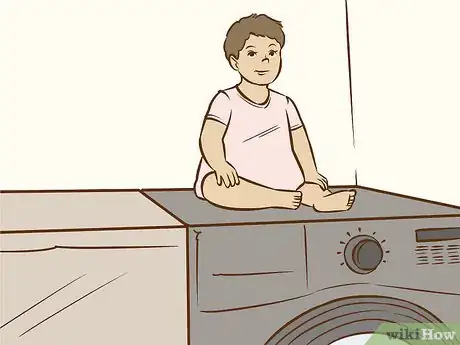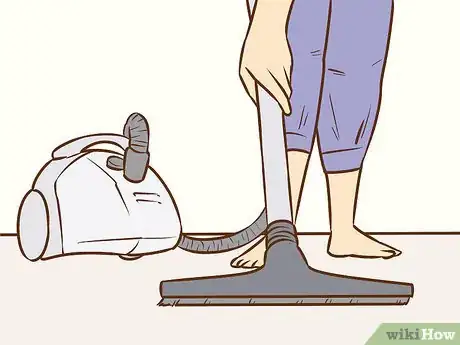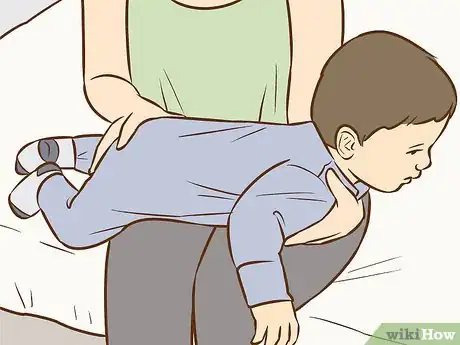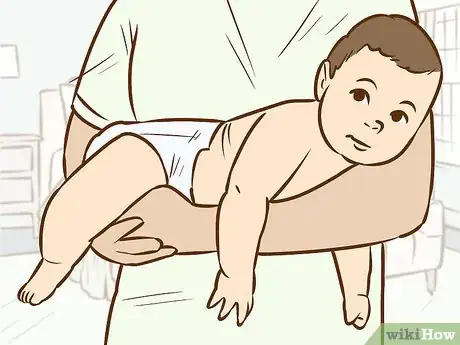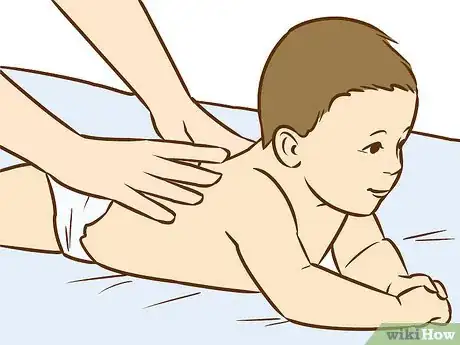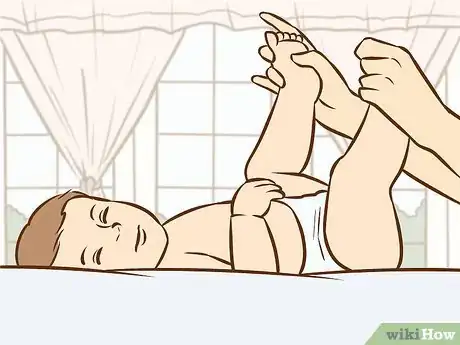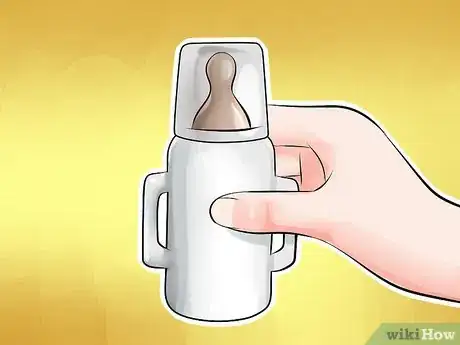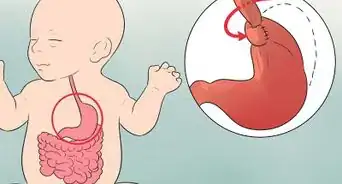This article was co-authored by Laura Marusinec, MD and by wikiHow staff writer, Christopher M. Osborne, PhD. Dr. Marusinec is a board certified Pediatrician at the Children's Hospital of Wisconsin, where she is on the Clinical Practice Council. She received her M.D. from the Medical College of Wisconsin School of Medicine in 1995 and completed her residency at the Medical College of Wisconsin in Pediatrics in 1998. She is a member of the American Medical Writers Association and the Society for Pediatric Urgent Care.
There are 7 references cited in this article, which can be found at the bottom of the page.
This article has been viewed 130,954 times.
Crying is a natural occurrence with a newborn, but a baby who seems to cry constantly may have colic. Colic can cause newborns to wail for several hours a day for up to three months, then just stop as suddenly as it appeared. Unfortunately, the best medical advice is to be patient and “wait it out,” and the evidence for the many colic remedies out there is largely anecdotal. But anecdotal evidence may do when your baby has been crying for five hours nonstop!
Steps
Soothing with Movement and Sound
-
1Swaddle your baby. They may not like the process, but the results can be amazing. Swaddling is believed to recreate the coziness of the womb, and may enhance the calming impact of other soothing steps.[1]
- Once swaddled, turn baby on their side and gently jiggle them. Shush them loudly — make sure they can hear you over their own screaming. Think about how loud the vacuum cleaner is — that's the kind of volume it might take to get their attention.[2]
-
2Try a baby swing. The recurring motion may soothe your shrieking baby and get them to stop crying, at least briefly.[3]
- While it’s tempting to let a crying baby sleep anywhere they please, experts recommend not letting babies sleep in swings, carriers, car seats, etc. — try to get them to sleep in a safe, secure crib.
Advertisement -
3Take them for a ride. Driving, strolling, or even carrying your baby around may provide some relief to both of you. Some people swear by car rides as a colic remedy — bundle the baby up, buckle them in, and within ten minutes in the car, their cries might be quieted.[4]
- Or, if you prefer fresh air and exercise, going for walks with a baby carriage can also work.
- If you have tasks or chores to do, try using a baby sling or carrier that holds the baby close to your body, yet leaves both hands free as you walk around the house.
-
4Put your baby on top of the washing machine or dryer. The vibrations can be calming to a baby. Secure the baby properly in a car seat or a baby bouncer.[5]
- Do not ever leave your baby on a washing machine or dryer unattended.
-
5Turn on a loud home appliance. Try the vacuum cleaner. It sounds odd, but many parents swear it works. Just set the baby in the bassinet or car seat and let them become fascinated by a sound louder than they're making.[6]
- Or, turn on a floor fan or window air conditioner. Make sure it’s an older, roaring type, not some new whisper-quiet model.
- You might also want to invest in a sound machine that mimics a mother's heart beat (or makes other white noise sounds). This can be a lifesaver for both parent and child.
-
6Jiggle the infant on your lap. Lay the baby on their stomach across your knees — but remember to support the head at all times. Jiggle your feet up and down and pat softly. This vibration can be very soothing.[7]
-
7Try a more calm and quiet approach if jiggling doesn't work. Instead of over-stimulating your baby's senses, see if reducing external stimulation works. Lie on your back in a quiet, dark place. Hold the baby firmly on your chest with their head over your heart. Raising your knees with your feet flat on a solid surface, rock yourself, calming the infant.[8]
Easing Tummy Discomfort
-
1Use the “colic carry.” Hold your baby stomach down, with their abdomen resting on your forearm. Support their head securely, either with your palm or the crook of your elbow. Walk around, or try rocking the baby back and forth, either very gently or a bit more quickly (but without sudden jerks or whipping motions).[9]
-
2Massage your baby’s midsection. While employing the “colic carry” or with the baby stomach-down on your legs, try massaging their middle and lower back. This may help relieve gas, and can provide soothing comfort regardless.[10]
- You can also try massaging their stomach while they are being held or are lying face-up. Use clockwise circular motions, as if trying to nudge the trapped gas upward or downward.[11] This may help to move the gas out of your baby’s body.
-
3Burp your baby midway through and after feedings. Burping your baby midway through a feeding and immediately after a feeding as well may also help to ease tummy discomfort.
-
4Pedal their legs. While your baby lies on their back, lift their legs and gently mimic the up-and-down motion of a bicyclist pumping the pedals. This alternating motion may help release gas pressure that could be contributing to their colic cries.[12]
-
5Give the baby a warm bath or sponge bath. Just as a warm soak can soothe your stress, it may help your baby as well. Wipe your infant down with a soft washcloth dipped in warm (not hot) water, or add some comfortably warm water to a baby tub for a calming bath.[13]
- Never leave a baby alone in or near a bath, no matter how little water is in the tub.
- Always check the water temperature yourself to prevent scalding.
-
6Change the mother and the baby's diets. Despite the mystery that still surrounds colic, it may be related to the ongoing development of an infant’s digestive system. Some foods that the mother eats — e.g. spicy foods, or potential allergens — may transfer to the breast milk and cause additional discomfort. Try avoiding a single type of food for three days or so, and see if baby shows any signs of improvement; if not, try another.[14]
- Adverse reactions to milk or soy might also be related to colic symptoms, so if you are giving your baby formula that is milk-based, you may want to try soy-based for a week to see if that helps (or vice versa).
- Talk to the pediatrician about formula and food recommendations.
-
7Watch for trapped air in the bottle. Check the bottle now and then to make sure that the formula is not coming out too quickly. You may also want to consider a different type of bottle if you notice that air gets trapped in it.
-
8Provide something soothing to suck. If baby begins to calm down slightly, try giving them something to suck on, like a pacifier or your finger. Gradually reduce the jiggling, shushing, etc. as they calm. If you’re lucky, baby will drift off to sleep as you place them in their crib.[15]
-
9Try a traditional baby stomach-ease tea. Teas made from ingredients like fennel, chamomile, thyme, or gripe water have been used for generations to give colic relief. A spoon before and after every feeding might help. Look for recipes online.
- Always consult your baby’s doctor first, however; don’t assume that “traditional” equals “always safe.” For instance, star anise is typically discouraged now because it may introduce potentially dangerous toxins.[16]
-
10Give a rectal catheter a shot. It may seem crazy, but using a rectal catheter like the Windi might relieve your baby of painful gas that could be contributing to the colic cries. The catheter reaches past the cramped muscles of the baby and releases the pent up gas.
- Used properly (e.g., not inserted more than intended), the product should be as safe as a typical rectal thermometer. But you may want to consult your baby's doctor first.
- Even if it is probably harmless, there's little evidence that it will actually help. Unfortunately, this is the case for most presumed colic remedies.[17]
-
11Talk to your pediatrician about probiotics. Some research has suggested that probiotics can help babies with colic. Talk to your pediatrician about whether or not you should give probiotics to your baby.[18]
Soothing Your Own Nerves
-
1Take quick breaks for your own mental health. If you simply cannot get your baby to stop crying, remember that it’s okay to step away for a moment. Place the baby in a safe spot (e.g. their crib), and take a minute to read a book, listen to music, or meditate.[19]
- Leave the room if you must, but don’t leave for too long, as a feeling of abandonment may make the crying worse.
-
2Rely on your support system for longer breaks. If you need more than a short break, call someone you trust to take over for an hour or two. If you have a spouse or other caregivers available, take shifts so no one gets burned out.[20]
- Remember — you are not a bad parent just because you need to take a break for yourself.
-
3Get help before you reach a breaking point. If your despair reaches a level in which you fear you might hurt yourself or your child, call for help right away. Countries around the world have hotlines dedicated to helping over-stressed parents.[21]
- In the U.S. — 24-Hour Parent Helpline: 1-888-435-7553; Crying Baby Hotline: 1-866-243-2229; Fussy Baby Warmline: 1-888-431-BABY
- In the UK — Parentline: 0808 800 2222; Parent Lifeline: 0114 272 6575
- In Australia — Parentline: 1300 30 1300
- In Canada — Parent Help Line: 1-800-668-6868
Warnings
- Constant cries can be a sign of something more severe. If the baby screams in an extremely high pitch, and is inconsolable, call your doctor's office. Always check with your pediatrician for the best in health care of your little one.⧼thumbs_response⧽
- Babies have limited sight and hearing skills, and fear of being abandoned is instinctive to them. Don't aggravate your baby's symptoms by making them feel alone.⧼thumbs_response⧽
- Never shake your baby! Shaking a baby can cause brain damage and even death. If you are becoming frustrated with your baby’s crying, call a friend or family member to help you.⧼thumbs_response⧽
- Colic usually lasts about two months. If it's more than two months, ask a doctor.⧼thumbs_response⧽
References
- ↑ https://www.helpguide.org/articles/parenting-family/when-your-baby-wont-stop-crying.htm
- ↑ https://www.happiestbaby.com/blogs/blog/the-5-s-s-for-soothing-babies
- ↑ https://www.babycentre.co.uk/x25005619/how-can-i-soothe-my-colicky-baby
- ↑ http://www.parents.com/baby/care/colic/how-to-soothe-a-colicky-baby/
- ↑ http://www.parents.com/baby/care/colic/how-to-soothe-a-colicky-baby/
- ↑ https://www.babycentre.co.uk/x25005619/how-can-i-soothe-my-colicky-baby
- ↑ https://www.helpguide.org/articles/parenting-family/when-your-baby-wont-stop-crying.htm
- ↑ http://www.parents.com/baby/care/colic/how-to-soothe-a-colicky-baby/
- ↑ http://www.parents.com/baby/care/colic/how-to-soothe-a-colicky-baby/
- ↑ http://www.parents.com/baby/care/colic/how-to-soothe-a-colicky-baby/
- ↑ https://www.babycentre.co.uk/x25005619/how-can-i-soothe-my-colicky-baby
- ↑ http://www.parents.com/baby/care/colic/how-to-soothe-a-colicky-baby/
- ↑ http://www.parents.com/baby/care/colic/how-to-soothe-a-colicky-baby/
- ↑ https://www.babycentre.co.uk/x25005619/how-can-i-soothe-my-colicky-baby
- ↑ https://www.babycentre.co.uk/x25005619/how-can-i-soothe-my-colicky-baby
- ↑ http://www.nhs.uk/Conditions/Colic/Pages/Treatment.aspx
- ↑ https://sciencebasedmedicine.org/the-windi-revolutionary-relief-for-colic-or-a-pain-in-the-butt/
- ↑ http://jamanetwork.com/journals/jamapediatrics/fullarticle/1812293
- ↑ https://www.helpguide.org/articles/parenting-family/when-your-baby-wont-stop-crying.htm
- ↑ https://www.helpguide.org/articles/parenting-family/when-your-baby-wont-stop-crying.htm
- ↑ https://www.helpguide.org/articles/parenting-family/when-your-baby-wont-stop-crying.htm



